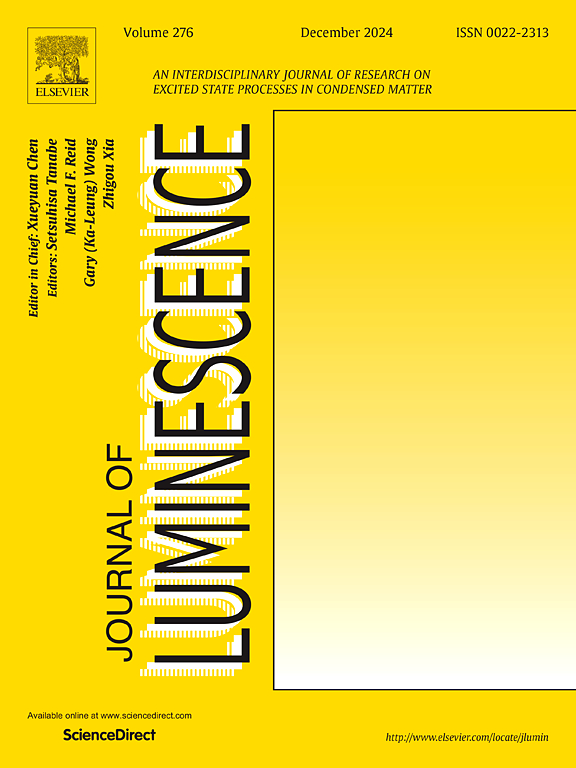Enhanced red upconversion luminescence in Fe3+-activated NaYF4: Yb, Er nanocrystals for rapid latent fingerprint recognition
IF 3.3
3区 物理与天体物理
Q2 OPTICS
引用次数: 0
Abstract
Traditional methods for latent fingerprint (LFP) detection often suffer from insufficient contrast and background interference, limiting their effectiveness in forensic applications, particularly in complex environments. This study introduces an innovative approach that combines Fe3+-doped NaYF4:Yb, Er upconversion nanoparticles (UCNPs) with digital image processing technology. By optimizing the Fe3+ doping concentration (15 % mmol) and synthesis temperature (220 °C), the red emission intensity at 655 nm was enhanced by 13.96 times compared to undoped samples. The amplified red emission originates from energy transfer of |2F7/2, 4T1g⟩ (Yb3+-Fe3+ dimer) to 4F9/2 (Er3+) states, coupled with crystalline field symmetry distortion induced by Fe3+ codoping. Dynamic studies of 4S3/2 and 4F9/2 states under 980 nm pulsed laser excitation, alongside diffuse reflectance analysis, corroborate the proposed upconversion mechanism. Additionally, The optimized UCNPs demonstrated high biocompatibility and stability, achieving LFP visualization with contrast ratios up to 85.03 % and structural similarity scores exceeding 91.58 % via MATLAB-based digital image processing, a significant improvement over conventional methods. This work establishes a robust, non-toxic LFP detection system with potential applications in forensic science.
Fe3+激活的NaYF4: Yb, Er纳米晶体增强红色上转换发光,用于快速潜在指纹识别
传统的潜在指纹(LFP)检测方法往往存在对比度不足和背景干扰的问题,限制了其在法医应用中的有效性,特别是在复杂环境中。本研究介绍了一种将Fe3+掺杂的NaYF4:Yb, Er上转换纳米颗粒(UCNPs)与数字图像处理技术相结合的创新方法。通过优化Fe3+掺杂浓度(15% mmol)和合成温度(220℃),可使样品在655 nm处的红光发射强度比未掺杂样品提高13.96倍。放大的红色发射源于| 2f7 / 2,4t1g⟩(Yb3+-Fe3+二聚体)到4F9/2 (Er3+)态的能量转移,加上由Fe3+共掺杂引起的晶体场对称畸变。4S3/2和4F9/2在980 nm脉冲激光激励下的动态研究,以及漫反射分析,证实了所提出的上转换机制。此外,优化后的UCNPs具有较高的生物相容性和稳定性,通过基于matlab的数字图像处理,实现了对比度高达85.03%的LFP可视化,结构相似性得分超过91.58%,比传统方法有显著提高。这项工作建立了一个强大的、无毒的LFP检测系统,在法医学中具有潜在的应用前景。
本文章由计算机程序翻译,如有差异,请以英文原文为准。
求助全文
约1分钟内获得全文
求助全文
来源期刊

Journal of Luminescence
物理-光学
CiteScore
6.70
自引率
13.90%
发文量
850
审稿时长
3.8 months
期刊介绍:
The purpose of the Journal of Luminescence is to provide a means of communication between scientists in different disciplines who share a common interest in the electronic excited states of molecular, ionic and covalent systems, whether crystalline, amorphous, or liquid.
We invite original papers and reviews on such subjects as: exciton and polariton dynamics, dynamics of localized excited states, energy and charge transport in ordered and disordered systems, radiative and non-radiative recombination, relaxation processes, vibronic interactions in electronic excited states, photochemistry in condensed systems, excited state resonance, double resonance, spin dynamics, selective excitation spectroscopy, hole burning, coherent processes in excited states, (e.g. coherent optical transients, photon echoes, transient gratings), multiphoton processes, optical bistability, photochromism, and new techniques for the study of excited states. This list is not intended to be exhaustive. Papers in the traditional areas of optical spectroscopy (absorption, MCD, luminescence, Raman scattering) are welcome. Papers on applications (phosphors, scintillators, electro- and cathodo-luminescence, radiography, bioimaging, solar energy, energy conversion, etc.) are also welcome if they present results of scientific, rather than only technological interest. However, papers containing purely theoretical results, not related to phenomena in the excited states, as well as papers using luminescence spectroscopy to perform routine analytical chemistry or biochemistry procedures, are outside the scope of the journal. Some exceptions will be possible at the discretion of the editors.
 求助内容:
求助内容: 应助结果提醒方式:
应助结果提醒方式:


